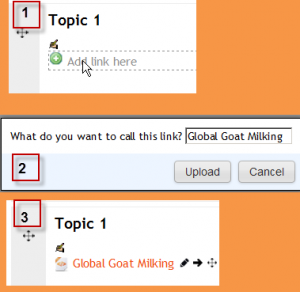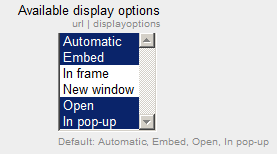URL resource settings: Difference between revisions
Helen Foster (talk | contribs) m (→Site administration settings: settings -> admin change) |
|||
| (23 intermediate revisions by 7 users not shown) | |||
| Line 3: | Line 3: | ||
# Turn editing on. | # Turn editing on. | ||
#From the the "Add an activity or resource" link (or, if not present, the "Add a resource" drop down menu),choose URL. All settings may expanded by clicking the "Expand all" link top right. | #From the the "Add an activity or resource" link (or, if not present, the "Add a resource" drop down menu),choose URL. All settings may expanded by clicking the "Expand all/Collapse all" link top right. | ||
==General== | ==General== | ||
*Give your URL a name and type (or copy/paste) the URL into the External URL box. If you need to search for the correct URL, click the Choose a link button. When you find and select your link,it will be automatically pasted into the box. | |||
*Give the URL a description if you wish, and tick the box to display that description on the course page if needed. | |||
[[File:31URL.png|thumb|400px|center|Adding a URL]] | |||
| | |||
==Appearance== | ==Appearance== | ||
For '''Display''' you have the following options. If you don't see an option, ask the administrator to enable it in ''Site administration >Plugins <Activity modules >URL.'' You can also have 'in frame' or 'New window' but these must be enabled by the administrator. | |||
* ''Automatic'' - Make the best guess at what should happen (probably what is wanted 99% of the time). | * ''Automatic'' - Make the best guess at what should happen (probably what is wanted 99% of the time). | ||
* ''Embed'' - Show the Moodle page with heading, blocks and footer. Show the title/description of the item and display the file directly in the page as well | * ''Embed'' - Show the Moodle page with heading, blocks and footer. Show the title/description of the item and display the file directly in the page as well | ||
* ''Open'' - No Moodle heading, blocks, footer or description - just show the file in the web browser (e.g. shows image, PDF, flash animation, taking up the whole browser window) | * ''Open'' - No Moodle heading, blocks, footer or description - just show the file in the web browser (e.g. shows image, PDF, flash animation, taking up the whole browser window) | ||
* ''In pop-up'' - Same as 'Open', but opens a new browser window to show this file (without the Moodle heading, blocks, etc) - this browser window also does not have all the menus | * ''In pop-up'' - Same as 'Open', but opens a new browser window to show this file (without the Moodle heading, blocks, etc) - this browser window also does not have all the menus in it. If you select this one, then you can specify the pop-up width and height. | ||
==URL variables== | |||
=== | |||
This section allows you to pass internal information as part of the URL. | |||
This is useful if the URL is actually an interactive web page that takes parameters, and you want to pass something like the name of the current user, for example. | |||
Another use is to create stable links that updates in each iteration of the course, for example: | |||
if you want to link to the student's user report, then you add the base URL to the External URL field, and then in the URL variables section, add 'id' to the first field and select 'id' from under the site heading, and then save changes. The result is a URL that always points to the student's user report. | |||
Example 1: https:// moodlesite.com/report/outline/user.php?id=00000&course=0000 is the path to a user's course outline report. | |||
https:// moodlesite.com/report/outline/user.php is the base URL | |||
?id=00000 is the first added parameter, so type id in the parameter box and in the dropdown select id under user | |||
&course=0000 is the second added parameter, so type course in the parameter box and in the dropdown select id under course | |||
Example 2: https:// moodlesite.com/grade/report/user/index.php?id=00000&userid=0000 is the path to a user's course user report | |||
https:// moodlesite.com/grade/report/user/index.php is the base URL | |||
?id=00000 is the first added parameter, so type id in the parameter box and in the dropdown select id under course | |||
&userid=0000 is the second added parameter, so type userid in the parameter box and in the dropdown select id under user | |||
A further use includes displaying all forums in a site, by using the base URL then adding add 'id' to the first field and selecting 'id' from under the site heading. Another use makes use of mailto:email@address. URL variables could then include the subject parameter followed by the 'Site full name'. E.g. if you wanted to email a teacher who taught multiple courses, if a student clicked the URL then the email would automatically fill the subject field, which would help the teacher to identify which course the student was in. | |||
==Common module settings== | ==Common module settings== | ||
| Line 82: | Line 66: | ||
Here you can specify the height of the top frame (containing the navigation) if you choose the "in frame" display option. Note:If your theme has a large header then the height should be increased to prevent horizontal and vertical scrollbars. | Here you can specify the height of the top frame (containing the navigation) if you choose the "in frame" display option. Note:If your theme has a large header then the height should be increased to prevent horizontal and vertical scrollbars. | ||
===Password=== | ===Password=== | ||
| Line 102: | Line 82: | ||
===Default values for activity settings=== | ===Default values for activity settings=== | ||
Here you can set the defaults for this resource. | Here you can set the defaults for this resource. | ||
===See also=== | |||
Form discussions: | |||
* [https://moodle.org/mod/forum/discuss.php?d=389552#p1570270 URL Resource - adding a URL Variable] | |||
[[de:Link/URL konfigurieren]] | [[de:Link/URL konfigurieren]] | ||
[[fr:Paramètres de l'URL]] | [[fr:Paramètres de l'URL]] | ||
[[es:Configuraciones del recurso URL]] | |||
Latest revision as of 20:17, 12 August 2019
Adding a URL resource to your course
- Turn editing on.
- From the the "Add an activity or resource" link (or, if not present, the "Add a resource" drop down menu),choose URL. All settings may expanded by clicking the "Expand all/Collapse all" link top right.
General
- Give your URL a name and type (or copy/paste) the URL into the External URL box. If you need to search for the correct URL, click the Choose a link button. When you find and select your link,it will be automatically pasted into the box.
- Give the URL a description if you wish, and tick the box to display that description on the course page if needed.
Appearance
For Display you have the following options. If you don't see an option, ask the administrator to enable it in Site administration >Plugins <Activity modules >URL. You can also have 'in frame' or 'New window' but these must be enabled by the administrator.
- Automatic - Make the best guess at what should happen (probably what is wanted 99% of the time).
- Embed - Show the Moodle page with heading, blocks and footer. Show the title/description of the item and display the file directly in the page as well
- Open - No Moodle heading, blocks, footer or description - just show the file in the web browser (e.g. shows image, PDF, flash animation, taking up the whole browser window)
- In pop-up - Same as 'Open', but opens a new browser window to show this file (without the Moodle heading, blocks, etc) - this browser window also does not have all the menus in it. If you select this one, then you can specify the pop-up width and height.
URL variables
This section allows you to pass internal information as part of the URL.
This is useful if the URL is actually an interactive web page that takes parameters, and you want to pass something like the name of the current user, for example.
Another use is to create stable links that updates in each iteration of the course, for example:
if you want to link to the student's user report, then you add the base URL to the External URL field, and then in the URL variables section, add 'id' to the first field and select 'id' from under the site heading, and then save changes. The result is a URL that always points to the student's user report.
Example 1: https:// moodlesite.com/report/outline/user.php?id=00000&course=0000 is the path to a user's course outline report. https:// moodlesite.com/report/outline/user.php is the base URL ?id=00000 is the first added parameter, so type id in the parameter box and in the dropdown select id under user &course=0000 is the second added parameter, so type course in the parameter box and in the dropdown select id under course
Example 2: https:// moodlesite.com/grade/report/user/index.php?id=00000&userid=0000 is the path to a user's course user report https:// moodlesite.com/grade/report/user/index.php is the base URL ?id=00000 is the first added parameter, so type id in the parameter box and in the dropdown select id under course &userid=0000 is the second added parameter, so type userid in the parameter box and in the dropdown select id under user
A further use includes displaying all forums in a site, by using the base URL then adding add 'id' to the first field and selecting 'id' from under the site heading. Another use makes use of mailto:email@address. URL variables could then include the subject parameter followed by the 'Site full name'. E.g. if you wanted to email a teacher who taught multiple courses, if a student clicked the URL then the email would automatically fill the subject field, which would help the teacher to identify which course the student was in.
Common module settings
Restrict access/Activity completion
(These settings are collapsed by default)
These settings are visible if Conditional activities and Activity completion have been enabled in the site and the course.
Drag and Drop a URL
Alternatively, if an administrator has enabled the experimental feature drag and drop upload of text/links in Settings > Site administration > Development > Experimental > Experimental settings, a link can be dragged into a section of the course and given a name, as shown in the images below.
URL module capabilities
Site administration settings
The URL module has additional settings which may be changed by an administrator in Administration > Site administration > Plugins > Activity modules > URL.
Frame height
Here you can specify the height of the top frame (containing the navigation) if you choose the "in frame" display option. Note:If your theme has a large header then the height should be increased to prevent horizontal and vertical scrollbars.
Password
Here you can add a password that will connect your users to a secure site. See this forum post for more details.
Include role names in parameters
Available display options
This setting allows you to add different ways the resource may be displayed on the course page. There are a number of defaults but you can add or change them here. Other display options are:
- In frame - show the Moodle heading and the file description, with the file displayed in a resizeable area below
- New window - very much like 'in pop-up', but the new window is a full browser window, with menus and address bar, etc.
Default values for activity settings
Here you can set the defaults for this resource.
See also
Form discussions:


